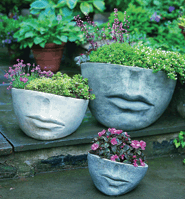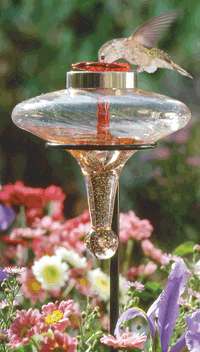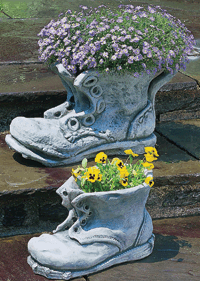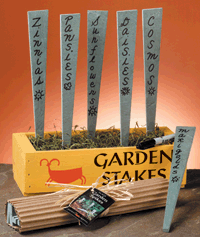Garden Accessories Take Root
Bold and Beautiful?
The experts agree that large is in for garden accessories. While that may be good news for many, how do you display and stock these large items if space is at a premium?
You'll want to actively use these planters and containers in your store, says Anthony Cilio, vice president of sales for Alfresco Home, of King of Prussia, PA. His company sells garden accessories in addition to its lines of lounge chairs, love seats and coffee tables. Here are some ideas for showcasing big containers and planters:
... Use them to store charcoal or grass seed.
... Use them to display dog toys or treats.
... Fill them with winter salt and place them at the door.
... And of course, plant flowers in them!
The options are endless. A word of caution: Make sure your planters and containers are food-safe before stocking them with edible products.
Going Green
 Alfredo Garcia-Lucio and Jim McKeever couldn’t understand why so many of the bird feeders they came across were so, well, plain. What they wanted for their garden seemed reasonable enough: a feeder that combined beautiful design and quality materials, which was also functional enough to keep the birds visiting their Colorado home happy.
Alfredo Garcia-Lucio and Jim McKeever couldn’t understand why so many of the bird feeders they came across were so, well, plain. What they wanted for their garden seemed reasonable enough: a feeder that combined beautiful design and quality materials, which was also functional enough to keep the birds visiting their Colorado home happy.
“We wanted something that would still accommodate the birds, but we wanted it prettier,” says Garcia-Lucio, who ultimately decided to design the feeder he had in mind.
This spurred the creation of PAR.A.SOL, Garcia-Lucio and McKeever’s 10-year-old Denver-based company that aims to provide alternatives to traditional notions of bird feeding and garden products. PAR.A.SOL’s handblown-glass designs are a far cry from generic feeders that at one time dominated the market, Garcia-Lucio says. “When we started this, all the feeders that were out there were either hunter green or barn red,” he says.
Natural progression
PAR.A.SOL’s example is indicative of a larger trend, of people embracing the luxury of living large outdoors, according to Susan McCoy, president of the Garden Media Group, a public relations and marketing communications firm in Chadds Ford, PA. “Consumers in all tax brackets are creating their own outdoor living style,” says McCoy.
In a report titled “Outdoor Living Takes a New Twist in 2007,” McCoy explains that the growing environmental consciousness movement has consumers both embracing the outdoors (starting with their own backyard) and paying attention to the choices they make there.
Seattle’s Bedrock Industries has capitalized on consumers’ eco-consciousness, says manager Chris Munford, by designing and creating garden accessories out of recycled materials and with an eye toward the environment. Particularly popular among the company’s many offerings are “lollipops,” recycled glass circles on metal stakes for yards and flower beds.
 The idea of a garden as a private haven from the stresses of modern life is catching on. Consumers like to feel a connection to their gardens, and pieces like sun catchers that bring imagery and symbolism to them is one way to achieve that, Munford says.
The idea of a garden as a private haven from the stresses of modern life is catching on. Consumers like to feel a connection to their gardens, and pieces like sun catchers that bring imagery and symbolism to them is one way to achieve that, Munford says.
Space isn’t necessarily a barrier. Whether the garden area is part of a smaller patio or a balcony, an elaborate deck or an expansive backyard, consumers are creating outdoor havens by selecting accessories that speak to their personal style. So it is that we have seen a rapid expansion in the garden accessories market: from items such as ornamental and artistic garden stakes, and varying styles and sizes of fountains, colorful pots and planters; to hummingbird feeders and bird houses, decorative flags, benches and sculptures.
From home to garden
Peter Cilio, creative director of the 24-year-old garden ornaments company Campania International, in Pennsburg, PA, also sees consumers increasingly using their gardens and backyard spaces as an extension of their indoor living spaces. “They’re looking at it as another space, another place to entertain and decorate. People are expressing their own individuality in their garden as well as in their home,” Cilio says. Campania International sells fountains, benches, statues and a gamut of garden accessories.
Christine O’Reilly, sales representative for Toland Home Garden, a Port Townsend, WA-based company specializing in decorative flag and garden gifts, has also noticed this trend. “I believe that most people have taken their homes to the max. Their indoor space is maxed and now they want to move into the backyard,” she says.
No matter the accessory, industry experts agree, it all comes down to creating an appealing and comfortable outdoor living space.
Doing the numbers
 According to the National Gardening Association, 83 percent of all U.S. households, or an estimated 91 million households, participated in one or more types of do-it-yourself lawn and garden activities in 2005. Both the percentage and the number of households were records, and the increase in lawn and garden participation was the biggest recorded in a single year since 2001. The NGA is a nonprofit organization, based in South Burlington, VT, devoted to educating the public about plants and gardening. It defined lawn and garden activities to include such things as planning a perennial garden, installing a bubbling pond and maintaining a kitchen window-sill herb garden.
According to the National Gardening Association, 83 percent of all U.S. households, or an estimated 91 million households, participated in one or more types of do-it-yourself lawn and garden activities in 2005. Both the percentage and the number of households were records, and the increase in lawn and garden participation was the biggest recorded in a single year since 2001. The NGA is a nonprofit organization, based in South Burlington, VT, devoted to educating the public about plants and gardening. It defined lawn and garden activities to include such things as planning a perennial garden, installing a bubbling pond and maintaining a kitchen window-sill herb garden.
According to the association, the 91 million households participating in lawn and garden activities was 9 million above than the previous five-year average, a fact that experts attribute to the boom in home sales in the recent past.
Households that participate in lawn and garden activities spent an average of $387 on those pursuits in 2005. That is $62 (or 13 percent) less than the $449 average in 2004, according to the garden association. Bruce Butterfield, the association’s market research director, says this may be because new lawn and garden enthusiasts spend more as their interest and expertise increase.
Selling garden all year round
Consumers think gardening in the spring, so sales in this category are largely seasonal, right? Not quite, says O’Reilly. “I see the garden industry as flourishing and burgeoning. It’s a 24-hours-a-day, 365-days-a-year market,” she says.
 “It does depend upon the market and the weather,” McCoy says. “If you’re in the South, your gardening season is year-round; but if you’re in Boston and Minneapolis, your garden season may not spike until Memorial Day.”
“It does depend upon the market and the weather,” McCoy says. “If you’re in the South, your gardening season is year-round; but if you’re in Boston and Minneapolis, your garden season may not spike until Memorial Day.”
“I think that it is just a natural cycle,” says Cilio. “In spring, people start to think again about the outdoors and their garden. They start to clean up and fix up their outdoor space, and are finally able to spend more time outdoors. With this in mind and summer coming up, it is natural to start to think about how you want to improve and accessorize your outdoor living space—to buy those pots you were thinking about last year, or the fountain for your patio.”
McCoy says retailers are smart to push garden accessories no matter the time of year. One of her suggestions: package garden accessories—a packet of seeds, a small shovel, pretty gardening gloves—and promote these gifts during the winter holidays. “Late March and April through mid-June are going to be your peak months, but for an avid gardener, we’re happy to get garden gifts year-round,” she says.
Garden variety
 As the popularity of window-sill gardens proves, gardening does not have to be a strictly outdoor activity. “We have a cat garden for the pet owner, and shamrock and heart-shaped gardens. We do cooking themes, too, like our Chef’s Helpers, where you can grow different herbs and use the clippings when cooking,” says Bill Roth, director of sales and marketing for Garden At Home, an Auburn, WA-based company that sells tabletop gardens and executive gifts, including art-glass trinkets; lanterns; and exclusively designed bonsai, Zen and miniature gardens.
As the popularity of window-sill gardens proves, gardening does not have to be a strictly outdoor activity. “We have a cat garden for the pet owner, and shamrock and heart-shaped gardens. We do cooking themes, too, like our Chef’s Helpers, where you can grow different herbs and use the clippings when cooking,” says Bill Roth, director of sales and marketing for Garden At Home, an Auburn, WA-based company that sells tabletop gardens and executive gifts, including art-glass trinkets; lanterns; and exclusively designed bonsai, Zen and miniature gardens.
Container gardening is another way in which consumers are getting creative with their gardens. “I think you’re going to see more and more of that,” Roth says. “With new home construction, the size of the property you get with the home has reduced dramatically. People will build a 3,000-square-foot home, but it’s on a smaller lot, so you have to utilize your deck to be able to do gardening. So people are buying containers, using clay pots for flowers, another one for tomatoes.”
There are many vendors who offer these larger containers and pots. Alfresco Home, of King of Prussia, PA, also sells garden accessories in addition to its lines of lounge chairs, love seats and coffee tables.
 “We have some small fountains and statuary planters that are perfect for gift stores,” says Cilio, of Campania International. “It’s a pretty extensive collection of garden accessories, especially planters, from cast-stone to terra cotta to glaze to lightweight.” In addition to larger garden pieces, Campania sells lightweight accessories, Cilio says. These items are reminiscent of the company’s earliest product, a terra cotta planter.
“We have some small fountains and statuary planters that are perfect for gift stores,” says Cilio, of Campania International. “It’s a pretty extensive collection of garden accessories, especially planters, from cast-stone to terra cotta to glaze to lightweight.” In addition to larger garden pieces, Campania sells lightweight accessories, Cilio says. These items are reminiscent of the company’s earliest product, a terra cotta planter.
Whatever the style, industry experts expect consumers to continue growing their garden accessory collections to further enhance their outdoor living spaces. “I think it’s a stress release for a lot of people,” says Roth, of Garden At Home. “I think it’s also a necessity. You’re so busy during the week, and yet you want to still make sure your lawn is pleasing to your eye and the people who drive by and come to your house.”























